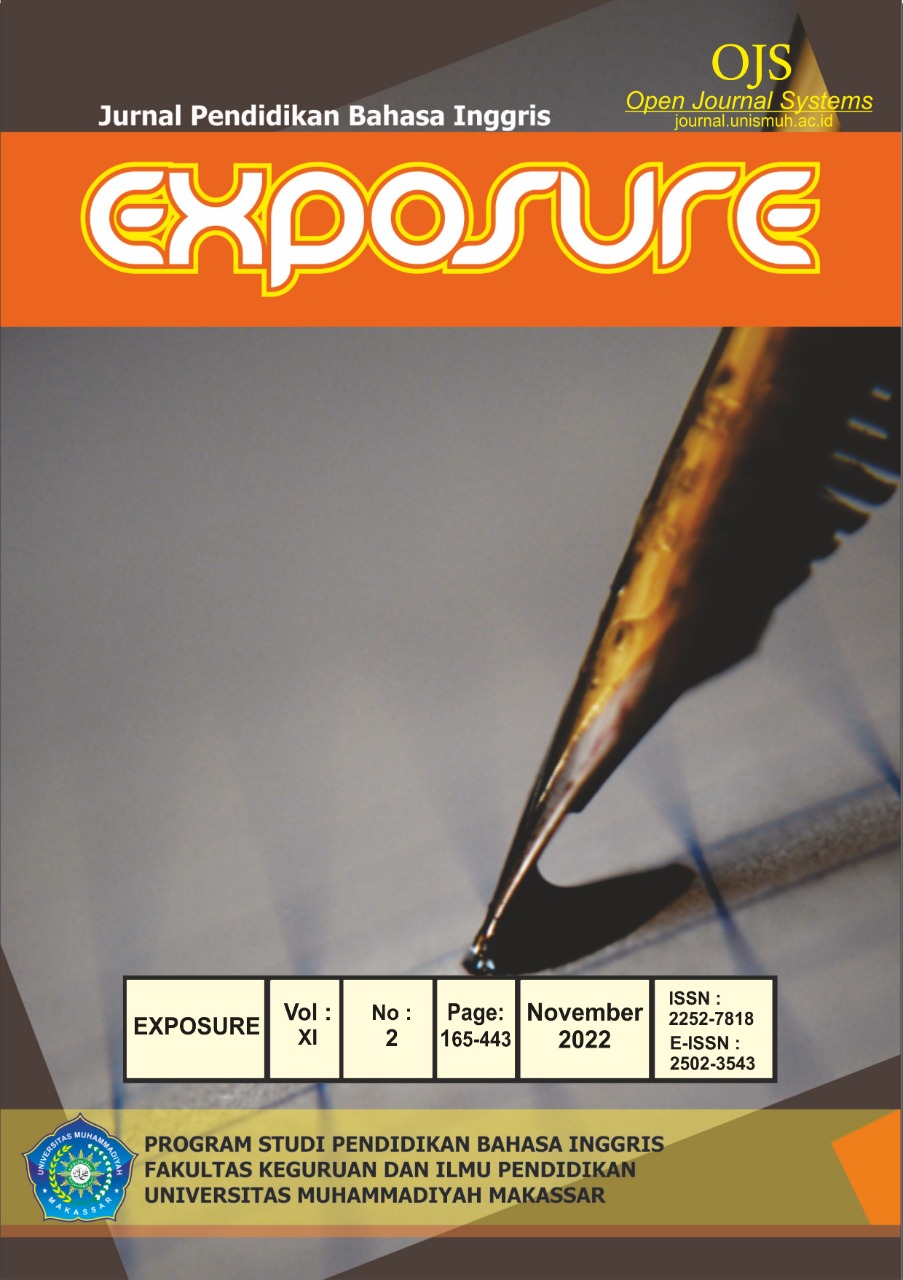THE EFFECT OF USING PICTURES ON STUDENTS' ACHIEVEMENT IN ENGLISH LANGUAGE VOCABULARY AT MUHAMMADIYAH UNIVERSITY OF BONE
DOI:
https://doi.org/10.26618/exposure.v11i2.9584Keywords:
English, Picture, VocabularyAbstract
English is now a subject studied at primary school until university level. That is because English is essential to students. The main purpose of this study was to determine how pictures affected the students’ ability in English vocabulary. The study's subjects were the English students at Muhammadiyah University of Bone. Only fifteen students were used in the study. The research focused on pre-experimental design. The experiment was conducted to evaluate the effect of the implementation of the picture on vocabulary learning. The researcher used a vocabulary test as the instrument.The outcome demonstrated that utilizing pictures to teach vocabulary can help students' vocabulary. Through the use of pictures, the students mastered vocabulary. The students' vocabulary t-test gives a result of 14,716, which is higher than the t-test value of 2.144. The significant difference in the student's test results between pre- and post-treatment periods (using the image).The analysis of the data revealed that the average score of the post-test (79) was higher than the mean score of the pretest (32).For the level of significance (a) = 0.05 and degree of freedom (df) = 14, then the value of t-table was 14,716, while the t-test value was greater than t-table (14,716>2.144). It can be concluded that there was not enough evidence to reject the alternative hypothesis (Ha) in this research. Therefore, the pictures' implied meaning can encourage students to comprehend the text
References
ALQAHTANI, M. (2015). The importance of vocabulary in language learning and how to be taught. International Journal of Teaching and Education, III(3). https://doi.org/10.20472/te.2015.3.3.002
Andarab, M. S. (2019). The Effect of Humor-Integrated Pictures Using Quizlet on Vocabulary Learning of EFL Learners. Journal of Curriculum and Teaching, 8(2). https://doi.org/10.5430/jct.v8n2p24
Asyiah, D. N. (2017). THE VOCABULARY TEACHING AND VOCABULARY LEARNING: PERCEPTION, STRATEGIES, AND INFLUENCES ON STUDENTS’ VOCABULARY MASTERY. Jurnal Bahasa Lingua Scientia, 9(2). https://doi.org/10.21274/ls.2017.9.2.293-318
Başoǧlu, E. B., & Akdemir, Ö. (2010). A comparison of undergraduate students’ English vocabulary learning: Using mobile phones and flash cards. Turkish Online Journal of Educational Technology, 9(3), 1–7.
Gruhn, S., Segers, E., & Verhoeven, L. (2019). Moderating role of reading comprehension in children’s word learning with context versus pictures. Journal of Computer Assisted Learning. https://doi.org/10.1111/jcal.12387
Hashemifardnia, A., Namaziandost, E., & Rahimi Esfahani, F. (2018). The Effect of Teaching Picture-books on Iranian Elementary EFL Learners’ Vocabulary Learning. Journal of English Language Teaching and Linguistics, 3(3), 247. https://doi.org/10.21462/jeltl.v3i3.151
Octaberlina, L. R., & Anggarini, I. F. (2020). Teaching Vocabulary Through Picture Cards in Islamic Elementary School A Case Study in Nida Suksa School, Thailand. Madrasah, 13(1). https://doi.org/10.18860/mad.v13i1.9649
Rakiyah, S., Pd, S., & Hum, M. (2018). THE EFFECTIVENESS OF TEACHING VOCABULARY BY USING PICTURES OF COMUNICATION AT STATE PRIMARY SCHOOL 023905 BINJE UTARA. In Tahun (Vol. 2, Issue 2). Online.
Sugiyono. (2015). Sugiyono, Metode Penelitian dan Pengembangan Pendekatan Kualitatif, Kuantitatif, dan R&D , (Bandung: Alfabeta, 2015), 407 1. Metode Penelitian Dan Pengembangan Pendekatan Kualitatif, Kuantitatif, Dan R&D.
Tsai, C. C. (2018). A comparison of EFL elementary school learners’ vocabulary efficiency by using flashcards and augmented reality in Taiwan. New Educational Review, 51(1). https://doi.org/10.15804/tner.2018.51.1.04
Downloads
Published
Issue
Section
License
Authors who publish with this journal agree to the following terms:
In order to assure the highest standards for published articles, a peer review policy is applied. In pursue of the compliance with academic standards, all parties involved in the publishing process (the authors, the editors and the editorial board and the reviewers) agree to meet the responsibilities stated below in accordance to the Journal publication ethics and malpractice statement.
Duties of Authors:
- The author(s) warrant that the submitted article is an original work, which has not been previously published, and that they have obtained an agreement from any co-author(s) prior to the manuscript’s submission;
- The author(s) should not submit articles describing essentially the same research to more than one journal;
- The authors(s) make certain that the manuscript meets the terms of the Manuscript Submission Guideline regarding appropriate academic citation and that no copyright infringement occurs;
- The authors(s) should inform the editors about any conflict of interests and report any errors they subsequently, discover in their manuscript.
Duties of Editors and the Editorial Board:
- The editors, together with the editorial board, are responsible for deciding upon the publication or rejection of the submitted manuscripts based only on their originality, significance, and relevance to the domains of the journal;
- The editors evaluate the manuscripts compliance with academic criteria, the domains of the journal and the guidelines;
- The editors must at all times respect the confidentiality of any information pertaining to the submitted manuscripts;
- The editors assign the review of each manuscript to two reviewers chosen according to their domains of expertise. The editors must take into account any conflict of interest reported by the authors and the reviewers.
- The editors must ensure that the comments and recommendations of the reviewers are sent to the author(s) in due time and that the manuscripts are returned to the editors, who take the final decision to publish them or not.
Authors are permitted and encouraged to post online a pre-publication manuscript (but not the Publisher’s final formatted PDF version of the Work) in institutional repositories or on their Websites prior to and during the submission process, as it can lead to productive exchanges, as well as earlier and greater citation of published work (see The Effect of Open Access). Any such posting made before acceptance and publication of the Work shall be updated upon publication to include a reference to the Publisher-assigned DOI (Digital Object Identifier) and a link to the online abstract for the final published Work in the Journal.




